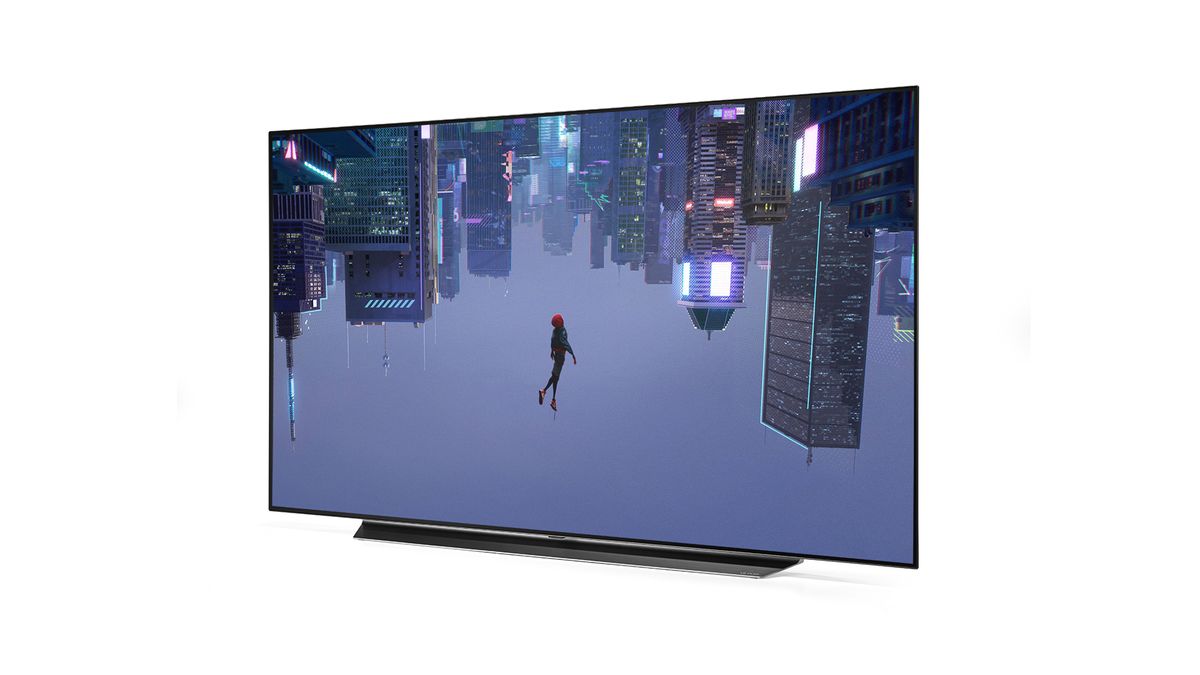What Hi-Fi? Verdict
LG has squeezed yet more performance from its OLED panel – the C9 is natural, dynamic and rich, and it sounds good, too
Pros
- +
Rich but natural pictures
- +
Fabulous contrast
- +
Strong sound
Cons
- -
Rival Samsung edges it at brightness extremes
- -
Beaten for motion
- -
Convoluted menus
Why you can trust What Hi-Fi?
The LG C9 has now been replaced by the CX, which is even better. If you can still find a C9 and it's had a big discount, it's well worth considering, but if you'd prefer the newer model, here's our LG OLED55CX review.
Despite all of its What Hi-Fi? Awards, LG is in a tricky position with its OLED TVs. According to accepted wisdom, OLED panels hit their performance limit in 2017, and from a hardware perspective, its 2019 OLEDs are similar to models from back then.
LG has also put many of its eggs in the OLED basket – not only is the upper end of the company’s own range entirely OLED-focused, it also makes panels that all other manufacturers use in their OLED models. All of which is to say that LG has more invested than anyone else in the continued supremacy of OLED as a TV technology.
Releasing the same sets every year won't keep OLED on top, so to maintain interest, LG has to look beyond the panel hardware. In 2018, the Alpha 9 processor was the focus – for 2019, LG made lots of noise about AI and the benefits it brings to the picture, sound and user experience.
In truth, LG is probably overplaying the impact of its AI tech, but the LG OLED65C9PLA (also available as the OLED65C9MLB via Currys) is a cracking set. So much so, in fact, that we made it our 2019 TV Product of the Year.
Features
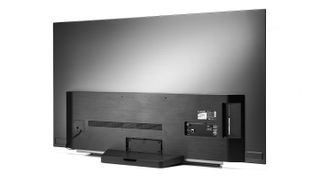
As was the case in 2018 (and continues to be the case in 2020), the C-class OLED gets you all of LG’s most advanced picture and processing tech in the most affordable package.
There is a cheaper 2019 LG OLED, the B9, but it has a less sophisticated processor and doesn’t have the new AI features. You can go more expensive, too, with the E9, W9 or R9, but while each offers a different design and sound solution, they are identical in terms of picture.
Even though it is the most basic model, the LG OLED65C9 is a lovely looking set. Viewed from the side, it looks striking – with its combination of a preposterously thin panel and a compact plastic appendage for the connections, processing technology and the speakers. Even at its thickest point, the 65-inch C9 measures just 4.7cm.
From the front, the speakers are totally invisible. All you can see is a uniformly thin, pure black bezel around the screen itself. It’s not far off being a floating display when wall-mounted, particularly in a darkened room. Those who aren’t wall-mounting will appreciate the subtle, low-profile stand, the colour of which differs subtly depending on whether you buy the widely available OLED65C9PLA on test here, or the Currys exclusive OLED65C9MLB. We're assured the stand is the only difference between the two models.
Most manufacturers are adding HDMI 2.1 features to the HDMI 2.0 inputs of their 2019 TVs, but LG is so far alone in including fully HDMI 2.1-certified sockets. Whether that’s actually a big deal is debatable. The likes of eARC (Enhanced Audio Return Channel) and VRR (Variable Refresh Rate) are currently of fairly niche appeal, and other manufacturers, such as Samsung, offer them via their HDMI 2.0-certified ports anyway. But it’s nice that the full spec is officially confirmed.
As well as those four HDMI 2.1 sockets, the C9 has three USBs, ethernet, optical and headphone outputs, and aerial and satellite connections. The latter is linked to a proper Freesat tuner, so is of actual use to UK buyers – many rivals only offer unordered access to a limited selection of channels via satellite.
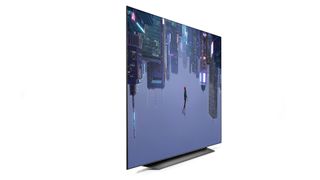
Under the skin is the second generation version of last year’s Alpha 9 processor, which adds AI technology designed to automatically optimise the picture and sound, based on the content being played and the room in which the TV is located.
It’s also designed to make the LG TV smarter by offering more intelligent voice interaction via LG’s own ThinQ, Google Assistant and Amazon Alexa, as well as content recommendations based on what you’ve previously watched, and also on the time of day.
LG’s webOS operating system looks and operates broadly the same as before, with boldly coloured ‘cards’ representing sources and apps. New this year are ‘AI Preview’, which adds a row of relevant content above the app you’ve highlighted, giving you access to specific shows or films on Netflix or Amazon, and ‘Intelligent Edit’, which automatically re-orders sources and apps based on usage.
The selection of apps is one of the most comprehensive out there. Netflix and Amazon Video are on board, in 4K and with Dolby Vision HDR (the TV also supports HDR10 and HLG, but not HDR10+), and pay-as-you-go movie streaming is available via Google Play Movies & TV and Rakuten, both also in 4K and HDR.
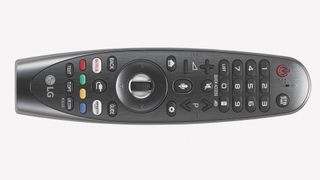
All of the UK’s main catch-up apps are here, including Now TV’s subscription-free access to Sky content, and Plex, which allows for streaming of your own digital media files. The only absence of real significance was Apple TV, but this has been added in a post-launch firmware update. AirPlay 2 is now on board as well.
LG’s remote remains more or less the same as last year. One of the most ergonomic zappers out there, it combines a good number of traditional buttons with a pointer function that allows you to highlight TV options by simply aiming at them. For many, it's an intuitive way to operate the TV, but the option to disable the pointer function entirely would be appreciated.
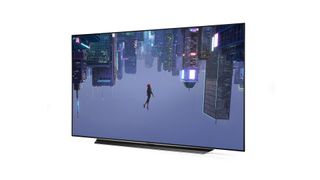
Screen type OLED
Resolution 4K
Operating system LG webOS
HDR formats HDR10, Dolby Vision, HLG
HDMI x4
USB x3
Optical x1
While webOS’s front end is bright, welcoming and responsive, the setting menus are less well thought out. Processes such as adjusting picture settings, for example, are trickier than they need to be.
LG seems intent on confusing users when it comes to picture settings. With standard dynamic range (SDR) content, there are no fewer than 10 picture presets to choose from, while there are six for HDR and five for Dolby Vision.
The settings within these presets are bizarre, too. Take Cinema and Cinema Home, for example. In theory, the difference is that Cinema Home is designed to give you the Cinema experience in a room that isn’t perfectly dark, so you may assume the two presets would be the same, but for brightness settings. But not only are there differences in sharpness and colour between the two, the actual settings at your disposal are different.
In Cinema, Colour Temperature is in a sub-menu labelled ‘Expert Controls’ and has five options, ranging from Cool to Warm3. In Cinema Home, Colour Temperature is measured on a 100-point scale from W50 to C50 and there is no ‘Expert Controls’ sub-menu at all. Other settings, for example Super Resolution, are also in a completely different place in the menu depending on which preset you’ve selected, making them harder to find.
We’ve no idea why LG has chosen to do this, but it’s disappointing to see that nothing has changed from last year’s sets.
The good news is that you can avoid much of this confusion by sticking with the standard preset, which only needs a few tweaks in order to look its best. Switch Energy Saving and all noise reduction settings off, change Aspect Ratio to Original, and add a few points to Sharpness, and you're just about there.
You may also want to experiment with the motion processing, which can be tweaked to look better than the overly processed, default Clear setting. We switch TruMotion to User, set Deblur to its maximum setting and Dejudder to its minimum – even a single point of Dejudder creates shimmer around tricky motion.
Picture
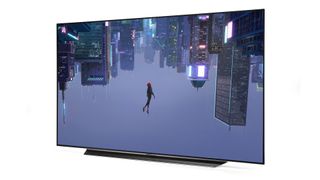
Tweaked accordingly, the C9 produces a lovely picture. We play Star Trek: Discovery from Netflix and black depth is as good as we’ve come to expect from OLED, while the ability to independently light or dim each individual pixel results in stunning contrast. Absolute brightness is limited compared to most high-end LCD-derived sets, but even the Samsung Q90R, which achieves black depth hitherto unseen from a non-OLED, can’t quite match the C9’s blackness. Besides, for an OLED the C9 goes brilliantly bright.
Colours are also lovely, with a slight richness lending a charming, organic warmth to skin tones and real splendor to sunrises and sunsets. LG’s OLEDs have always majored in naturalism, and it’s no different here – there’s real subtlety and nuance to shades.
Detail levels are up there with the best in class but, again, without suggesting artificial enhancement. Freckles, wrinkles, scars and spots are mercilessly resolved, as are the intricacies of the Discovery itself when viewed from space.
Motion isn’t perfect, with the TruMotion processing adding extra shimmer, but with Dejudder switched off and Deblur at its maximum, you get a performance that is a little sharper, but devoid of the horrible soap opera effect.
Our only real criticism of the LG C9 when viewing HDR content is in a slight lack of detail at the two extremes of the brightness scale. Compared to Samsung's Q90R, both very dark and very light detail are a touch lacking. Blanket blacks and whites are stunning – movie credits have never looked so good – but dark and bright areas that should be more nuanced aren’t quite there.
We watch Guardians Of The Galaxy Vol.2 and in the view of the Sovereign planets, the large golden panel of the main planet is a little washed-out, while the dark areas of space lack some of the subtler hues that the Samsung reveals.
This isn’t an issue with SDR content, presumably because the LG isn’t stretching itself as much in terms of overall contrast. Here the TV’s rich but authentic approach to colours works wonders, and the picture is supremely natural.
Throw some upscaling into the mix, whether from a Blu-ray, DVD or one of the onboard tuners, and the C9 provides an astonishingly clean, smooth image with more detail than you should reasonably expect. Some rivals go a little sharper with 1080p and 576p content, but none are as balanced or controlled.
Meanwhile, gamers will be pleased to hear that this LG has an input lag of less than 14ms, which is about as low as it can currently get. VRR, which reduces screen tearing by matching the refresh rate of the screen to the frame-rate of the signal it’s receiving, will be exciting to some Xbox One and PC gamers, while ALLM (Automatic Low Latency Mode) means the TV will automatically switch to Game mode when it senses a signal from a console.
Sound
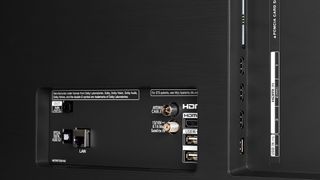
Experience tells us that the Dolby Atmos logo on a TV is no guarantee of sound quality, and it’s rare that completely hidden speakers sound great. So, it’s a surprise that the C9 is a real sonic upgrade on its predecessor and a more accomplished audio performer than many rivals.
The Dolby Atmos mode adds width, weight and dynamism, while voices are projected effectively. It’s an atmospheric sound for a TV, even though it doesn’t stretch into the room in the way you might expect from Dolby Atmos. That said, occasionally an effect does appear surprisingly far out to the left or right. It’s an impressive delivery by the standards of integrated sound solutions.
Even when the signal being received isn’t Dolby Atmos, the LG has an AI Sound mode that has a similar, atmosphere-enhancing effect, particularly with the Sound Tuning, which tailors the audio presentation to your room.
Standard, two-channel TV sound is generally best left unprocessed by LG’s sound modes, but even this is weighty and open, with greater directness than last year’s sets.
Verdict
We may be close to OLED’s hardware limitations, but each year LG squeezes more performance out of its panels, producing a picture that defies expectations.
This year is no different. The C9 is a superb performer that majors on naturalism in the way its predecessors did while adding an extra dollop of dynamism in terms of colours and contrast. Its audio is impressive, too.
Choosing between it and Samsung’s 2019 flagship, the Q90R, is no easy task. Each set has its own selection of pros and cons, but the case for the C9 is made stronger by its more affordable price, which is currently a third off its RRP.
Of course, both TVs have now been replaced by 2020 equivalents, and LG's CX is an even better TV than this Award-winning C9. The C9 is still worth getting if you can find a discounted set out there, but if you're looking for the new model, check out our OLED55CX review.
SCORES
- Picture 5
- Features 5
- Sound 5
MORE:
What Hi-Fi?, founded in 1976, is the world's leading independent guide to buying and owning hi-fi and home entertainment products. Our comprehensive tests help you buy the very best for your money, with our advice sections giving you step-by-step information on how to get even more from your music and movies. Everything is tested by our dedicated team of in-house reviewers in our custom-built test rooms in London, Reading and Bath. Our coveted five-star rating and Awards are recognised all over the world as the ultimate seal of approval, so you can buy with absolute confidence.
-
solvetech There is a glaring weakness in this TV - It only has a single tuner so if you want to record a programme you also have to watch it at the same time - if you switch channels the recording stops. On a £2,000 TV I expected better. There is absolutely no point in recording on a tv with a single tuner. So don't throw away your humax!Reply -
chasm22 In the USA much of the recording is done in conjunction with your cable tv provider. You just click the record button on the show or movie you wish to record. This can, of course, be done well in advance by using the programming guide provided by them.Reply -
Neilrich In the absence of a sub 50" oled I bought a 49" Samsung qled which does have 2 tuners and the freesat picture quality is far superior compared to using my old humax. I hope the new LG CX 48" has 2 tuners but I suspect not.Reply
